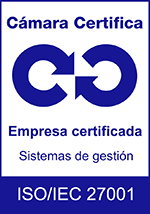Last Thursday 25th, the webinar “Challenges in Carbon Footprint Calculation and Digitization“.organized by Laragon Consultores and EHS Techniques, which addressed the role of organizations in controlling and reducing their greenhouse gas emissions in order to avoid the most serious impacts of climate change, regardless of their size or the sector to which they belong.
The introduction to the webinar was given by Antonio Aragón, Partner at Laragon, who highlighted how the measurement of environmental criteria and indicators is becoming increasingly important in the decision-making processes of investors and financial institutions, becoming a key factor for the solvency of companies and their access to capital markets.
“The world is undergoing a process of energy transition in which companies play a key role. It is no longer enough for companies to comply with hygiene requirements alone. They must now put the maximum of their capabilities into the comprehensive governance of their emissions to contribute to the global goal of zero emissions as the epicenter of sustainability strategies.”
How to link the circular economy strategy in organizations with the carbon footprint calculation scope 3?
The first presentation was given by Victor del Coso, Consulting Partner at EHS Techniques, who explained the main challenges faced by organizations when including the quantification of Scope 3 emissions and their alignment with a circular economy strategy, also complying with decarbonization plans in the 2030 and 2050 horizons.
Victor del Coso explained in detail the methodology for the identification of Scope 3 as the main way to define what emissions to include in organizations and also explained how all the calculation and effort involved results in more efficiency and cost savings, greater opportunities for GHG reduction throughout the value chain, among other important benefits such as strengthening the corporate reputation of a company and its suppliers. He also presented several practical cases depending on the characteristics of each organization.
Técnicas Reunidas Case Study: Scope 3 Calculation and its application in Waste Management
Waste management as part of Scope 3 carbon footprint measurement is an example of an effective circular economy strategy. This was evidenced in the presentation given by Laura de Eugenio Caprotti, Senior Environmental Consultant at Técnicas Reunidas, who highlighted key aspects for achieving environmental management objectives.
As a key factor, he indicated that the first aspect to take into account is to identify the entire life cycle of materials and direct emissions (from the organization itself) and indirect emissions (from third parties: suppliers, transporters), i.e. everything involved in the company’s operations.
Among the waste management strategies, he emphasized the need to include in the waste managers’ contract the mandatory reporting of the categorization of waste removed, quantification, final destination and percentage of reuse.
At the procedural level, he indicated that the methodology applied by Técnicas Reunidas is based on the inclusion of data reported by the waste managers. The digitalization of all your consumption and invoices in the ENABLON tool allows the exhaustive and detailed calculation of the equivalent tons of CO2, and finally the proposal of annual reduction targets in the medium and long term.
Digitization of the integrated management of a decarbonization program
The advantages of the digitalization of the carbon footprint calculation were presented by Kevin Esposito, Consulting Manager of Laragon, who indicated that although many companies calculate the scopes 1 and 2 of their emissions, and that a priori they are relatively simple measurements, many multinationals face problems with data collection, calculation of uncertainties, management of Protocols and Emission Factors, among others.
In these cases, it is essential to have a solution that automates the measurement of activity, performs conversions, manages calculations and documents all processes.
The evolution of technology ensures, among other things, that companies can be confident that their management systems are keeping regulatory content and standards up to date, documenting every change and ensuring compliance, and helping managers to respond to verification processes and any stakeholders.
In relation to the measurement of scope 3, the digitization of its measurement, using specialized software for this purpose, reduces management times by the organization.
“The automation of these processes solves challenges such as the overall monitoring of data and its traceability and origin, facilitates consolidation and reporting.”
For Espósito, the choice of the best solution for calculating the carbon footprint is fundamental and he presented a series of recommendations for choosing the right management software provider.

About the companies organizing the webinar.
LARAGON: Technology consultant with 15 years of experience specializing in digitization projects of Environmental, Sustainability, Safety, Health, Risk and Compliance management systems. They work with global clients from all types of industries and with operations mainly in Spain and Latin America.
WEB: www.laragon.es
EHS TECHNIQUES: Consulting firm specialized in Environment, formed by a senior team coming from large multinational companies in the sector and that combines the advantages of excellence, quality and safety of large companies, with the flexibility, agility and personalized treatment of consultancies. Its services are structured in 4 typologies: Legal Compliance Assurance and Permitting, Sustainability and Circular Economy, Environmental Liability and Liabilities, and Accredited Inspection in Contaminated Soil and Fugitive Emissions.
#LaragonWebinar, #CarbonFootprintCalculation, #CircularEconomy, #EnvironmentalConsulting, #EHSConsulting, #EvaluationandManagement, #ClimateChangeManagement, #EnvironmentalManagement, #LaragonEnvironment, #ODSObjectives, #ODSforBusiness, #NonFinancialReporting, #GHG, #GRI, #CDP, #SASB, #EnvironmentalPerformance, #GreenhouseGasInventory, #EnergyEfficiency, #ODSManagement, #ESGManagement, #WaterConsumption, #WasteEmissionsandManagement, #EINFD, #ESGMonitoring, #ResponsibleSupplyChain, #ManagementOfIndicatorsandScorecards, #StrategyTracking, #ESGSoftware



